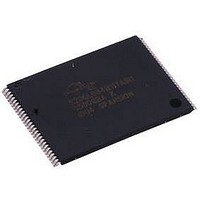S29GL01GP11FFIR20 Spansion Inc., S29GL01GP11FFIR20 Datasheet - Page 38

S29GL01GP11FFIR20
Manufacturer Part Number
S29GL01GP11FFIR20
Description
Flash - NOR IC
Manufacturer
Spansion Inc.
Datasheet
1.S29GL01GP11FFIR20.pdf
(80 pages)
Specifications of S29GL01GP11FFIR20
Memory Size
1000Mbit
Memory Configuration
128K X 16
Ic Interface Type
CFI, Parallel
Access Time
110ns
Supply Voltage Range
3V To 3.6V
Memory Case Style
TSOP
No. Of Pins
64
Cell Type
NOR
Density
1Gb
Access Time (max)
110ns
Interface Type
Parallel
Boot Type
Not Required
Address Bus
27/26Bit
Operating Supply Voltage (typ)
3/3.3V
Operating Temp Range
-40C to 85C
Package Type
Fortified BGA
Sync/async
Asynchronous
Operating Temperature Classification
Industrial
Operating Supply Voltage (min)
3V
Operating Supply Voltage (max)
3.6V
Word Size
8/16Bit
Number Of Words
128M/64M
Supply Current
110mA
Mounting
Surface Mount
Pin Count
64
Lead Free Status / Rohs Status
Compliant
Available stocks
Company
Part Number
Manufacturer
Quantity
Price
Company:
Part Number:
S29GL01GP11FFIR20
Manufacturer:
SPANSION
Quantity:
1 000
38
7.8.2
7.8.3
7.8.4
DQ6: Toggle Bit I
DQ2: Toggle Bit II
Reading Toggle Bits DQ6/DQ2
Toggle Bit I on DQ6 indicates whether an Embedded Program or Erase algorithm is in progress or complete,
or whether the device has entered the Erase Suspend mode. Toggle Bit I may be read at any address, and is
valid after the rising edge of the final WE# pulse in the command sequence (prior to the program or erase
operation), and during the sector erase time-out.
During an Embedded Program or Erase algorithm operation, successive read cycles to any address that is
being programmed or erased causes DQ6 to toggle. When the operation is complete, DQ6 stops toggling.
After an erase command sequence is written, if all sectors selected for erasing are protected, DQ6 toggles for
approximately 100
Embedded Erase algorithm erases the unprotected sectors, and ignores the selected sectors that are
protected.
The system can use DQ6 and DQ2 together to determine whether a sector is actively erasing or is erase-
suspended. When the device is actively erasing (that is, the Embedded Erase algorithm is in progress), DQ6
toggles. When the device enters the Erase Suspend mode, DQ6 stops toggling. However, the system must
also use DQ2 to determine which sectors are erasing or erase-suspended. Alternatively, the system can use
DQ7 (see
If a program address falls within a protected sector, DQ6 toggles for approximately 1
command sequence is written, then returns to reading array data.
DQ6 also toggles during the erase-suspend-program mode, and stops toggling once the Embedded Program
Algorithm is complete.
See the following for additional information:
Toggle Bit I on DQ6 requires either OE# or CE# to be de-asserted and reasserted to show the change in
state.
The “Toggle Bit II” on DQ2, when used with DQ6, indicates whether a particular sector is actively erasing (that
is, the Embedded Erase algorithm is in progress), or whether that sector is erase-suspended. Toggle Bit II is
valid after the rising edge of the final WE# pulse in the command sequence. DQ2 toggles when the system
reads at addresses within those sectors that have been selected for erasure. But DQ2 cannot distinguish
whether the sector is actively erasing or is erase-suspended. DQ6, by comparison, indicates whether the
device is actively erasing, or is in Erase Suspend, but cannot distinguish which sectors are selected for
erasure. Thus, both status bits are required for sector and mode information. Refer to
outputs for DQ2 and DQ6. See
Whenever the system initially begins reading toggle bit status, it must read DQ7–DQ0 at least twice in a row
to determine whether a toggle bit is toggling. Typically, the system would note and store the value of the
toggle bit after the first read. After the second read, the system would compare the new value of the toggle bit
with the first. If the toggle bit is not toggling, the device has completed the program or erases operation. The
system can read array data on DQ7–DQ0 on the following read cycle. However, if after the initial two read
cycles, the system determines that the toggle bit is still toggling, the system also should note whether the
value of DQ5 is high (see
determine again whether the toggle bit is toggling, since the toggle bit may have stopped toggling just as DQ5
went high. If the toggle bit is no longer toggling, the device has successfully completed the program or erases
operation. If it is still toggling, the device did not complete the operation successfully, and the system must
write the reset command to return to reading array data. The remaining scenario is that the system initially
determines that the toggle bit is toggling and DQ5 has not gone high. The system may continue to monitor the
toggle bit and DQ5 through successive read cycles, determining the status as described in the previous
paragraph. Alternatively, it may choose to perform other system tasks. In this case, the system must start at
the beginning of the algorithm when it returns to determine the status of the operation. Refer to
more details.
Note
When verifying the status of a write operation (embedded program/erase) of a memory sector, DQ6 and DQ2
toggle between high and low states in a series of consecutive and contiguous status read cycles. In order for
DQ7: Data# Polling on page
μ
s, then returns to reading array data. If not all selected sectors are protected, the
DQ5: Exceeded Timing Limits on page
S29GL-P MirrorBit
Figure 11.14 on page 64
36).
Figure
D a t a
®
Flash Family
7.4,
S h e e t
Figure 11.13 on page
for additional information.
39). If it is, the system should then
S29GL-P_00_A13 November 17, 2010
64, and
μ
Table 7.17
s after the program
Table
7.17.
Figure 7.4
to compare
for
















